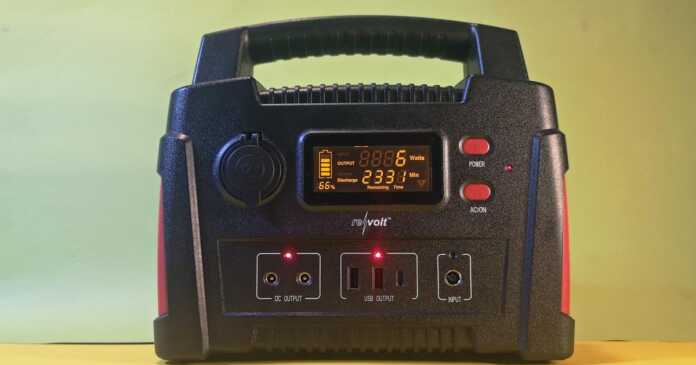The mobile power storage ZX3012 from Revolt comes with a 230 V socket and has an output of up to 600 W. Despite the possibility of charging via photovoltaic, this power station is not suitable for every application. TechStage explains why and names alternatives.
Power stations with solar power electrical consumers independently of the power grid. Thanks to various connection options including 230 V socket, USB ports and high continuous output, the devices are ideal for leisure, work and as an emergency power supply. The internal batteries can be charged either via the power pack, via a 12 V socket in the vehicle or with the help of a photovoltaic panel. The devices offer maximum flexibility.
This power station test is part of the Outdoor and Camping theme worlds . Here we show, for example , high-tech gadgets for hiking , binoculars with a range finder or explain what to look out for when buying a flashlight .
This individual test is about a mid-range power station from the manufacturer Revolt. In addition to a socket with up to 600 W, a fair price in German specialist shops and the compact size with a capacity of at least 420 Wh are attractive. The test device was made available to us by Pearl, where it cost 430 euros at the time of the test.
With dimensions of around 27 × 24 × 15 cm and a weight of 4 kg, the Revolt power station is one of the more compact models in the previous test field. The device still fits well in a large backpack. However, the fixed carrying handle gets in the way here. If this were foldable, the device would be even more compact and you could also stack objects on it. The design is reminiscent of the Flashfish, Novoo or Xmund power stations, starting with the choice of colour. The dark gray and orange plastic case is at least well made and makes a solid impression. Four rubber feet ensure a secure stand. It’s a pity that the connections aren’t protected by covers.
The 12 V car socket (cigarette lighter 10 A), the status display and the switches for direct and alternating current are in the top row on the front. Underneath are two 12V circular sockets (10A), the three USB sockets (2 x USB-A with 2A, 1x USB-C with PD up to 18W) and the power input socket (Solar 18V to 20V max 70 W) to find. The emergency light and power button are on the side of the housing, which accommodates the positioning of the handle, since the power station can be used as an XL flashlight in case of doubt. The 230 V socket with up to 600 W is located in the middle under the bright LED.
In addition to the power station, a quick start guide and a suitable power supply unit (power supply unit 16.8 V 5 A) are also included in the scope of delivery. Solar panels are optionally available. The Li-Ion batteries used in the ZX3012 are slightly lighter than comparable LiFePO4 batteries. The downside is the significantly shorter lifespan of only around 500 to 800 charge cycles – that’s pretty little in comparison. LiFePO4 batteries, as in the Bluetti EB70 (test report) , retain 80 percent usable capacity even after over 3000 cycles.
The operation of the ZX3012 is self-explanatory thanks to clear labeling and a clear layout of the control elements. To switch the power station and the respective outputs on and off, simply press the DC power button for several seconds. The same applies to activating and switching through the light modes of the side LEDs. To switch the 230 V socket on and off, the direct current must also be activated. This is unusual, but is not noticeable in consumption.
After switching on, the status display lights up in bright orange. However, the contrast is not particularly high and the backlight turns off again after just a few seconds. This saves electricity, but is moderately clear. A longer time interval would make sense here. Although something can be seen even without lighting, Revolt basically delivered one of the worst displays that we have had in the test field so far. It’s a pity, because in addition to the remaining capacity in percent, the input and output power and the remaining runtime are also displayed here and the screen would actually be very practical if only it were easier to read. In addition, the displayed output power always seems a bit too high.
Before charging for the first time, we test the maximum power of the mobile socket. To do this, we plug in various consumers such as tools, kitchen appliances and other electronic gadgets. The power station also delivers the specified 600 W per 230 V socket in practice (according to the current meter, we needed a maximum of 590 W) – however, this is not a pure sine wave and so the power supply for some sensitive devices is not guaranteed! An absolute rarity in the power stations tested so far. Even no-name providers deliver a pure sine wave for the 230 V outputs. Although our laser printer requires less than the maximum output, it still refused to work for this reason. For desktop PCs, notebooks, drills, jigsaws, Power stations and coolers, on the other hand, work without any problems. However, sensitive electronics and measuring equipment could refuse to work. From our point of view, this is a hard limitation and therefore a big minus point.
If the output power of 600 W is exceeded, the power station switches off the AC output after a few seconds, which worked reliably in the test. A few seconds with up to 1000 W are possible, but the output switches off immediately if the output is higher. The power station lacks the power for a kettle, toaster or fan heater. However, this is not surprising given the size and price – moderate consumers such as chargers for notebooks, cameras or drones are ideally suited for this model.
With a power output of around 200 W, the internal fan remains whisper-quiet, but from 250 W it turns up audibly. In case of doubt, the volume under low load can also be endured overnight in the tent. It’s a pity, however, that this fan noise also occurs when the USB ports are used and that there can also be a slight whistling. Other solar generators remain silent, at least with USB consumers.
After the performance tests, we charge the empty Li-Ion batteries (420 Wh) to 100 percent with the included power adapter. The positive thing is that charging is completely silent. It’s a pity, however, that the charging process takes around 8 hours, which is excruciatingly long – especially compared to other power stations. The Ecoflow Delta (test report) and Anker 757 (test report) , which are much more lengthy with over 1200 Wh , only need about one and a half hours to charge.










